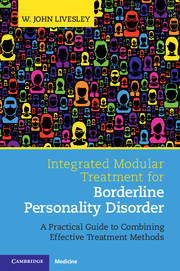 Integrated Modular Treatment for Borderline Personality Disorder
Integrated Modular Treatment for Borderline Personality Disorder Book contents
- Frontmatter
- Dedication
- Contents
- Preface
- Section 1 Introduction and Framework for Understanding Borderline Personality Disorder
- Section 2 Assessment and Treatment Planning
- Section 3 General Treatment Modules
- Introduction
- 7 General Treatment Module 1: Structure
- 8 General Treatment Module 2: Treatment Relationship
- 9 General Treatment Module 3: Consistency 101ment Module 3: Consistency
- 10 General Treatment Module 4: Validation
- 11 General Treatment Module 5: Self-Reflection
- 12 General Treatment Module 6: Motivation
- Section 4 Safety, Containment, and Engagement: The Initial Phase of Treatment
- Section 5 Improving Emotional Regulation and Modulation
- Section 6 Exploration and Change: Treating Interpersonal Problems
- Section 7 Constructing an Adaptive Sense of Self
- Section 8 Retrospect and Prospect
- References
- Index
7 - General Treatment Module 1: Structure
from Section 3 - General Treatment Modules
Published online by Cambridge University Press: 16 February 2017
- Frontmatter
- Dedication
- Contents
- Preface
- Section 1 Introduction and Framework for Understanding Borderline Personality Disorder
- Section 2 Assessment and Treatment Planning
- Section 3 General Treatment Modules
- Introduction
- 7 General Treatment Module 1: Structure
- 8 General Treatment Module 2: Treatment Relationship
- 9 General Treatment Module 3: Consistency 101ment Module 3: Consistency
- 10 General Treatment Module 4: Validation
- 11 General Treatment Module 5: Self-Reflection
- 12 General Treatment Module 6: Motivation
- Section 4 Safety, Containment, and Engagement: The Initial Phase of Treatment
- Section 5 Improving Emotional Regulation and Modulation
- Section 6 Exploration and Change: Treating Interpersonal Problems
- Section 7 Constructing an Adaptive Sense of Self
- Section 8 Retrospect and Prospect
- References
- Index
Summary
Structure is one of the most important and neglected aspects of therapy. Although evaluations of treatment outcome note the importance of a structured, focused, and theoretically coherent approach, discussion of the topic is usually confined to the treatment contract. However, “structure” in integrated modular treatment (IMT) is a broader concept. It refers to the multiple factors that organize and shape treatment: the conceptual frameworks for understanding borderline personality disorder (BPD) and treatment; the context in which treatment occurs; the daily routine of scheduled activities when treatment is hospital or residentially based; the therapeutic stance and interpersonal approach of therapists and staff; an understanding of the work of therapy; and the treatment plan and contract discussed in the previous chapter.
Description of the general treatment modules begins with structure because this module establishes the conditions for therapy whereas the other general modules address the treatment process. Structure is important because patients with BPD have difficulty structuring their lives, and indeed their inner experience, hence it is important that the therapist structures treatment. The various components of structure make treatment possible by establishing treatment boundaries, creating expectations, and clarifying what is and what is not acceptable. The structure created sets the course of therapy, helps to settle and contain reactivity, creates predictability, and promotes the feelings of safety and security needed for therapeutic work.
Implementation of structured treatment begins with an explicit treatment model. This is needed to manage the complexity of BPD and the ever-changing issues raised in treatment. A clearly defined model is especially important with IMT because it provides the guidelines for coordinating the delivery of an eclectic combination of interventions. Hence the emphasis placed earlier on frameworks for understanding of both BPD and therapy. However, it is not sufficient to have an explicit treatment model; therapy also has to be delivered in a way that is consistent with its intent and design.
- Type
- Chapter
- Information
- Integrated Modular Treatment for Borderline Personality DisorderA Practical Guide to Combining Effective Treatment Methods, pp. 81 - 87Publisher: Cambridge University PressPrint publication year: 2017


